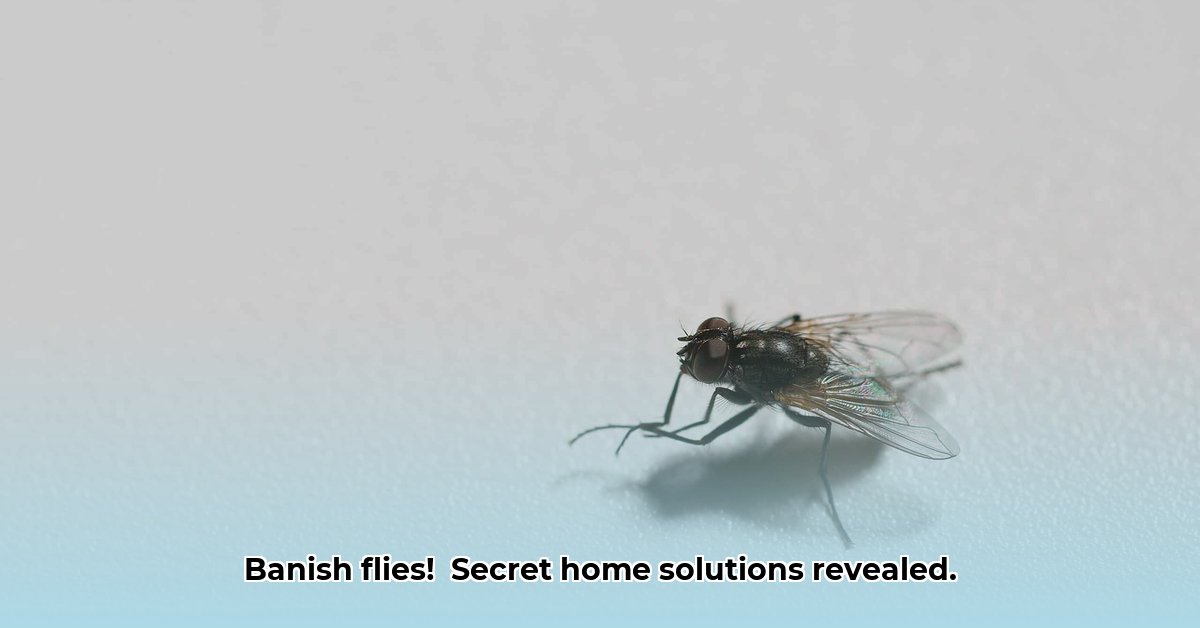Flies buzzing around your kitchen can be more than just annoying; they can be a hygiene concern. This guide is designed to provide you with a clear understanding of what attracts flies and, more importantly, actionable strategies to eliminate them and prevent future infestations. We’ll explore simple home solutions and more advanced tactics to help you achieve a fly-free home environment. For broader pest control, learn about other household pests like rodents: Pest Control Info.
What Are Flies Attracted To? Understanding Fly Attractants
Understanding what draws these pesky insects into your living space is the crucial first step to maintaining a clean and fly-free life. The essence lies in making your home less appealing to them, a process that involves managing their food sources and breeding grounds. By understanding their preferences, you can actively outsmart them and reclaim your space.
The Fly’s All-You-Can-Eat Buffet: Identifying Irresistible Smells and Substances
Flies are far from picky eaters; they’re opportunistic feeders attracted to anything decaying or overly ripe. The primary culprits include:
- Rotting food: Decaying food scraps are a major attractant for flies.
- Spoiled fruit: Overripe fruit emits strong odors that draw flies in.
- Overflowing garbage cans: Garbage provides a feast of decaying organic matter.
- Pet waste: Flies, particularly house flies and blow flies, are drawn to the odors emanating from pet feces.
- Animal Carcasses: Decomposing animal remains, even those hidden within walls, can attract flies.
These sources release powerful odors that act like a gourmet invitation to flies. Additionally, sweet substances and damp environments are prime attractants, as many fly species require moisture for survival and reproduction. This includes leaky pipes as well.
Beyond the Obvious: Unveiling Hidden Fly Attractants
Besides food sources, consider these less obvious attractants:
- Warmth and light: Flies are drawn to warmth and artificial light sources and often congregate near windows and outdoor lights.
- Cozy temperatures: Flies thrive in warm environments; that’s why their population increases during the summer months.
- Sweet liquids: Spilled soda, syrup, alcohol, or any sugary substance can attract flies with their tempting content.
- Dirty drains: Sludge buildup in drains offers an appealing feeding and breeding ground for certain fly species.
- Other flies: They are drawn to the presence of other flies and even the smell of fly specks on walls.
Outsmarting Flies: A Three-Part Plan for Fly Control & Prevention
Eradicating flies requires a multipronged approach. Think of it as building a fortress against these invaders: starvation, direct action, and invasion prevention.
1. Starving the Problem: Eliminating Food Sources to Prevent Fly Breeding
- Empty Trash Regularly: Dispose of garbage daily to prevent build-up. Use bins with tight-fitting lids.
- Wipe Up Spills Immediately: Clean up any spills to eliminate potential food sources.
- Seal Food Tightly: Store leftovers in airtight containers to contain odors.
- Scoop the Poop: Regularly clean up pet waste, as it’s a significant attractant.
- Fix Those Leaks: Repair leaky pipes and faucets to prevent standing water.
- Clean Garbage Disposal: Sanitize your garbage disposal regularly.
- Regularly clean pet food bowls: Remove any leftover food bits to avoid attracting flies.
2. Direct Action: Proven Methods for Eliminating Existing Flies
- Swat the Problem: A traditional fly swatter can be surprisingly effective for quick elimination.
- Strategic Trapping: Deploy sticky or bait traps near windows to capture flies; these can draw in considerable numbers of flies.
- Homemade traps: Make a simple trap using apple cider vinegar, sugar, and dish soap.
- Flypaper strips: Hang resin-coated strips to catch flies.
- Call in the Pros: For severe infestations, consider professional pest control services, which offer advanced tools and expertise.
- Hand-held vacuum: Use a handheld vacuum to suction the fly away.
3. Preventing Future Invasions: Long-Term Fly Prevention Strategies
- Seal Up Entry Points: Repair or replace damaged screens and door seals to block entryways. Seal cracks and crevices where flies can slip inside.
- Improve Airflow: Increase ventilation to reduce humidity, making your home less attractive to flies.
- Clean Your Drains: Regularly clean and disinfect drains to prevent breeding. Flush drains regularly with hot water.
- Tidy Up Outside: Remove attractants from your yard, such as pet waste, rotting leaves, and overgrown vegetation.
- Keep doors and windows closed: Ensure tightly sealed windows and keep doors closed when not in use.
Understanding Fly Behavior: A Powerful Tool to Deter Flies Long-Term
Knowing how flies breed and sustain themselves is vital in controlling them. Flies typically lay their eggs in moist, decaying matter. By maintaining consistent cleanliness, you disrupt their life cycle, making your home less appealing for reproduction for the common house fly.
Remember that consistent cleanliness and attention to detail create your best defense against those pesky flies!
How to Prevent Different Fly Species Infestations: Strategic Fly Control
Key Takeaways:
- Flies are attracted to decaying matter, sugary substances, and moisture, understanding these is key.
- A multi-pronged approach combining sanitation, prevention, and targeted elimination works best.
- Different fly species require tailored strategies for optimal results.
- Prevention is better than reactive control; regular maintenance is crucial.
What Attracts Flies? Unlocking Fly Magnetism
Why do flies gravitate toward your home’s interior? It’s all about their survival needs. Flies seek food, water, and breeding locations. Here’s a more detailed look:
- Food Sources: Rotting garbage, sweet drink spills, and fermenting fruit. Houseflies crave decaying organic matter, while fruit flies target fermenting fruit.
- Breeding Grounds: Stagnant water in drains or leaky pipes provides ideal hatching conditions.
- Easy Access: Open windows and gaps in structures serve as fly highways.
- Outdoor lighting: Drawn by outdoor lighting and food odors, flies will take every opportunity to slip into a house.
Strategic Steps for Fly Control: Fly Prevention Techniques
Preventing fly infestations requires a proactive, multi-faceted approach:
- Sanitation is Paramount: Regularly clean, dispose of garbage, and keep surfaces clean.
- Eliminate Breeding Sites: Clean drains with bleach, fix leaks promptly—moisture is their friend.
- Seal Entry Points: Repair screens and caulk gaps to shut down their access network.
- Strategic Trapping: Use vinegar or UV light traps against particular species.
- Consider Professional Help: If infestations are stubborn, seek assistance and professional solutions.
Tailoring Your Approach to Different Fly Species: Targeted Fly Elimination
Different flies have different preferences. While basic principles apply, targeting specific fly species improves effectiveness.
- House Flies: Focus on eliminating decaying organic filth, feces, and rotting meat.
- Fruit Flies: Target sugary substances, spilled soda, and overripe fruits.
- Drain Flies: Address moist climates and organic materials in drains.
Maintaining a Fly-Free Zone: Long-Term Prevention Strategies
Consistent sanitation, regular inspections, and maintaining barriers are more effective than reacting to infestations.
Effective Fly Control in Kitchens: Proven Tactics & Home Remedies
Key Takeaways:
- Flies are drawn to filth, spills, and unsanitary conditions; sanitation is key.
- Effective control combines preventative and elimination methods.
- DIY solutions like traps and repellents can be very effective and eco-friendly.
What Attracts Flies to Your Kitchen? Fly Havens
Flies are attracted to the smells and sights of food and decaying organic material. Leftover food, overflowing trash cans, and damp sponges are invitations. Understanding this is half the battle. Dirty dishes and spilled juice are magnets.
Proven Tactics for Fly Elimination: Simple Fly Eradication
Once a fly problem exists, quick action is essential. Methods to deal with an infestation:
- Immediately clean up spills and crumbs.
- Empty trash frequently.
- Wash dishes promptly.
- Use fly traps.
- Employ natural repellents like peppermint or lavender.
- Use a fly swatter to deal with single flies.
Prevention Strategies: Maintain a Fly-Free Kitchen
Preventing a fly infestation is easier than dealing with one. Try this:
- Regular cleaning is key: Clean countertops, sweep floors, and regularly clean appliances.
- Proper food storage: Seal food tightly to prevent fly detection.
- Repair damaged screens: Ensure window screens are in good condition.
- Maintain good ventilation: Good airflow prevents odor build-up that attracts flies.
- Address moisture issues: Ensure proper drainage and ventilation.
DIY Fly Repellents: Effective Fly Control
DIY options include:
- Vinegar trap: Apple cider vinegar and dish soap attract and trap flies.
- Essential oil spray: Peppermint or lavender in water repel flies.
- Herb garden: Planting basil and mint
- Why an App Appeared on My Phone Unexpectedly - November 22, 2025
- How to Stop Unwanted Apps from Automatically Downloading on Android - November 21, 2025
- Why Are Android Games Installing Themselves on Your Phone? - November 20, 2025










